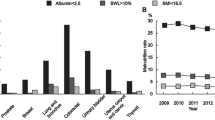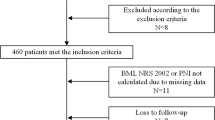Abstract
Purpose
Poor nutritional status has been associated with increased postoperative morbidity and mortality in surgical patients. The purpose of this study is to evaluate if decreased nutritional parameters correlate with increased postoperative complications regardless of other risk factors in the gynecologic cancer patient.
Methods
A retrospective chart review was performed among women who underwent surgical management for gynecologic malignancies from October 2006 to June 2008. Variables included age, race, medical comorbidities, cancer type/stage, preoperative albumin, absolute lymphocyte count (ALC), and body mass index (BMI), estimated blood loss (EBL), intraoperative blood transfusion (BT), intraoperative or postoperative complications, intensive care unit (ICU) admissions, hospital readmissions, reoperations, and cancer recurrence.
Results
Three hundred gynecologic oncology patients with preoperative nutritional parameters were included in the study. Decreased albumin was significantly associated with more postoperative complications (p < 0.001), hospital readmissions (p = 0.01), reoperations (p = 0.03), ICU admissions (p < 0.001), and cancer recurrence (p < 0.001). Decreased ALC and BMI preoperatively was also significantly associated with higher incidence of cancer recurrence (p = 0.01, p = 0.01). Surgical cases involving increased EBL (p = 0.01, p < 0.001) and more BT (p < 0.001, p < 0.001) had significantly more postoperative complications and more ICU admissions. Multivariable logistic regression found preoperative albumin to be an independent predictor of increased postoperative complications.
Conclusions
Decreased albumin is significantly associated with more postoperative complications, hospital readmissions, reoperations, ICU admissions, and cancer recurrence. This nutritional parameter is an important predictor of postoperative morbidity and mortality. Thus, it is important to assess nutritional status preoperatively and offer nutritional support or alternate treatment options if necessary.
Similar content being viewed by others
References
Laky B, Janda M, Bauer J et al (2007) Malnutrition among gynaecological cancer patients. Eur J Clin Nutr 61:642–646
Ottery FD (1994) Cancer cachexia: prevention, early diagnosis, and management. Cancer Pract 2:123–131
Lipschitz DA (1988) Protein-energy malnutrition. Hosp Pract (Off Ed) 23:87–99
McClave SA, Mitoraj TE, Thielmeier KA et al (1992) Differentiating subtypes (hypoalbuminemic vs. marasmic) of protein-calorie malnutrition: incidence and clinical significance in a university hospital setting. JPEN J Parenter Enteral Nutr 16:337–342
Berek JS, Hacker NF (2005) Practical gynecologic oncology, 4th edn. Lippincott Williams & Wilkins, Philadelphia
Detsky AS, Baker JP, O’Rourke K et al (1987) Predicting nutrition-associated complications for patients undergoing gastrointestinal surgery. JPEN J Parenter Enteral Nutr 11:440–446
Daley J, Khuri SF, Henderson W et al (1997) Risk adjustment of the postoperative morbidity rate for the comparative assessment of the quality of surgical care: results of the national veterans affairs surgical risk study. J Am Coll Surg 185:328–340
Symeonidis PD, Clark D (2006) Assessment of malnutrition in hip fracture patients: effects on surgical delay, hospital stay and mortality. Acta Orthop Belg 72:420–427
Casey J, Flinn WR, Yao JS et al (1983) Correlation of immune and nutritional status with wound complications in patients undergoing vascular operations. Surgery 93:822–827
Jain G, Mukerji G, Dixit A et al (2007) The impact of nutritional status on the outcome of Indian patients undergoing neurosurgical shunt surgery. Br J Nutr 98:944–949
Rapp-Kesek D, Stahle E, Karlsson TT (2004) Body mass index and albumin in the preoperative evaluation of cardiac surgery patients. Clin Nutr 23:1398–1404
Geisler JP, Linnemeier GC, Thomas AJ et al (2007) Nutritional assessment using prealbumin as an objective criterion to determine whom should not undergo primary radical cytoreductive surgery for ovarian cancer. Gynecol Oncol 106:128–131
Alphs HH, Zahurak ML, Bristow RE et al (2006) Predictors of surgical outcome and survival among elderly women diagnosed with ovarian and primary peritoneal cancer. Gynecol Oncol 103:1048–1053
Santoso JT, Canada T, Latson B et al (2000) Prognostic nutritional index in relation to hospital stay in women with gynecologic cancer. Obstet Gynecol 95:844–846
Muller JM, Brenner U, Dienst C et al (1982) Preoperative parenteral feeding in patients with gastrointestinal carcinoma. Lancet 1:68–71
The Veterans Affairs Total Parenteral Nutrition Cooperative Study Group (1991) Perioperative total parenteral nutrition in surgical patients. N Engl J Med 325:525–532
Bellantone R, Doglietto GB, Bossola M et al (1988) Preoperative parenteral nutrition in the high risk surgical patient. JPEN J Parenter Enteral Nutr 12:195–197
Detsky AS, Baker JP, O’Rourke K et al (1987) Perioperative parenteral nutrition: a meta-analysis. Ann Intern Med 107:195–203
Dempsey DT, Mullen JL, Buzby GP (1988) The link between nutritional status and clinical outcome: can nutritional intervention modify it? Am J Clin Nutr 47:352–356
Heyland DK, Montalvo M, MacDonald S et al (2001) Total parenteral nutrition in the surgical patient: a meta-analysis. Can J Surg 44:102–111
Conflict of interest
None.
Author information
Authors and Affiliations
Corresponding author
Rights and permissions
About this article
Cite this article
Kathiresan, A.S.Q., Brookfield, K.F., Schuman, S.I. et al. Malnutrition as a predictor of poor postoperative outcomes in gynecologic cancer patients. Arch Gynecol Obstet 284, 445–451 (2011). https://doi.org/10.1007/s00404-010-1659-y
Received:
Accepted:
Published:
Issue Date:
DOI: https://doi.org/10.1007/s00404-010-1659-y




